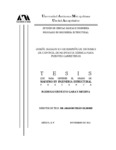Mostrar el registro sencillo del ítem
Diseño basado en desempeño de sistemas de control de respuesta sísmica para puentes carreteros
| Colaborador: | Teran Gilmore, Amador |
| Autor: | Garay Medina, Rodrigo Ernesto |
| Fecha de publicación: | 2014-11 |
| URI: | http://hdl.handle.net/11191/6264 |
| Descripción: | 88 páginas. Maestría en Ingeniería Estructural. |
| Resumen: | Uno de los temas que mayores discusiones causa en la actualidad es la viabilidad económica de usar sistemas de control. Mientras que algunos ingenieros contienden que su uso implica una mayor inversión económica; estudios recientes indican que en ocasiones dicho incremento es marginal cuando se considera el costo inicial de construcción, y han demostrado que el costo se reduce considerablemente cuando se toman en cuenta los costos totales durante la vida útil del sistema estructural. En el caso particular de un puente, se ha llegado a mencionar que el incremento marginal del costo directo de construcción puede ser ampliamente justificado cuando se considera la reducción del daño en la subestructura y, por tanto, los costos de reparación después de la ocurrencia de eventos sísmicos intensos. No es de extrañar entonces que el uso de dispositivos de control en puentes quede enfocado a mantener los elementos estructurales de la subestructura dentro de su rango elástico de comportamiento. En el presente estudio se considera un sistema de dos grados de libertad, para el cual se plantean sus hipótesis y limitaciones. Se basan los cálculos en un planteamiento con dinámica no clásica bajo la cual se desarrollan los análisis dinámicos paso a paso de los sistemas de dos grados de libertad. Este resultado es comparado con los obtenidos por medio de una teoría lineal para sistemas aislados de puentes carreteros que desarrolla expresiones para estimar la demanda de desplazamientos tanto del tablero como de la pila, aplicados a un puente carretero en concreto reforzado ubicado en la república de El Salvador. |
| Resumen: | In recent years, systems have been widely used to control the seismic response of structures located in areas of high seismicity. Among other things, these systems allow limited structural damage through control of strength and displacement demands and sometimes concentrating it in structural fuses that can be replaced easily. In a context in which the use of control systems offers many advantages over the use of traditional structural systems, it is necessary to mention that the design of these devices requires methodologies that involve multiple design iterations for the definitive structural propertiescontrol devices and structural system that accommodates them. Sometimes, the amount ofcomputation involved and the complexity of the design methodologies discourage the use of control systems in the structural design practice. It is therefore important to develop simple methodologies that rely on the basics of mechanics, allow the structural engineer designing an innovative structural system, and establish simple and reasonable manner its relevant structural properties. Refinement in the analysis is then intended to optimize the preliminary design that although conceived, converges to the final design in no or few iterations. One of the issues that further discussions is the economic feasibility of using control systems. While some engineers contend that its use implies a greater economic investment; recent studies indicate that in some cases the increase is marginal when you consider the initial cost of construction, and have shown that the cost is considerably reduced when the total costs are taken into account during the lifetime of a structural system. In the particular case of a bridge, it has come to be mentioned that the marginal increase in the direct cost of construction can be widely justified when considering the reduction of the damage in the substructure and thus repair costs after the occurrence of intense seismic events. It is not surprising then that the use of control devices on bridges remain focused on maintaining the structural elements of the substructure within its elastic range of behavior This study considers a system of two degrees of freedom, for which their assumptions and limitations arise. The calculations are based on an approach to non-classical dynamics under which the time-history analyses of two degrees of freedom system are developed. This result is compared with those obtained by a linear theory for isolated highway bridges that develops expressions to estimate the demand for travel both board and battery systems, applied to a highway bridge in reinforced concrete located in the Republic of El Salvador. |
| Formato: | |
| Idioma: | spa |
| Editor: | Universidad Autónoma Metropolitana (México). Unidad Azcapotzalco. Coordinación de Servicios de Información. |
| Materias: | INGENIERÍA Y TECNOLOGÍA::CIENCIAS TECNOLÓGICAS::TECNOLOGÍA DE LA CONSTRUCCIÓN::PUENTES |
| Clasificación LC: | TG302 |
| Materias: | Bridges--Earthquake effects. |
| Materias: | Puentes -- Efectos de los terremotos. |
| Materias: | Puentes -- Diseño y construcción |
| Materias: | Análisis estructural (Ingeniería). |
| Título: | Diseño basado en desempeño de sistemas de control de respuesta sísmica para puentes carreteros |
| Tipo de publicación: | Tesis de maestría |
| Audiencia: | students |
| Audiencia: | researchers |
| División: | División de Ciencias Básicas e Ingeniería. |
| Nivel del grado: | Maestría. |
| Otorgante del grado: | Universidad Autónoma Metropolitana (México). Unidad Azcapotzalco. |
| Nombre del Grado: | Maestría en Ingeniería Estructural. |
| Origen del formato: | Born digital |



